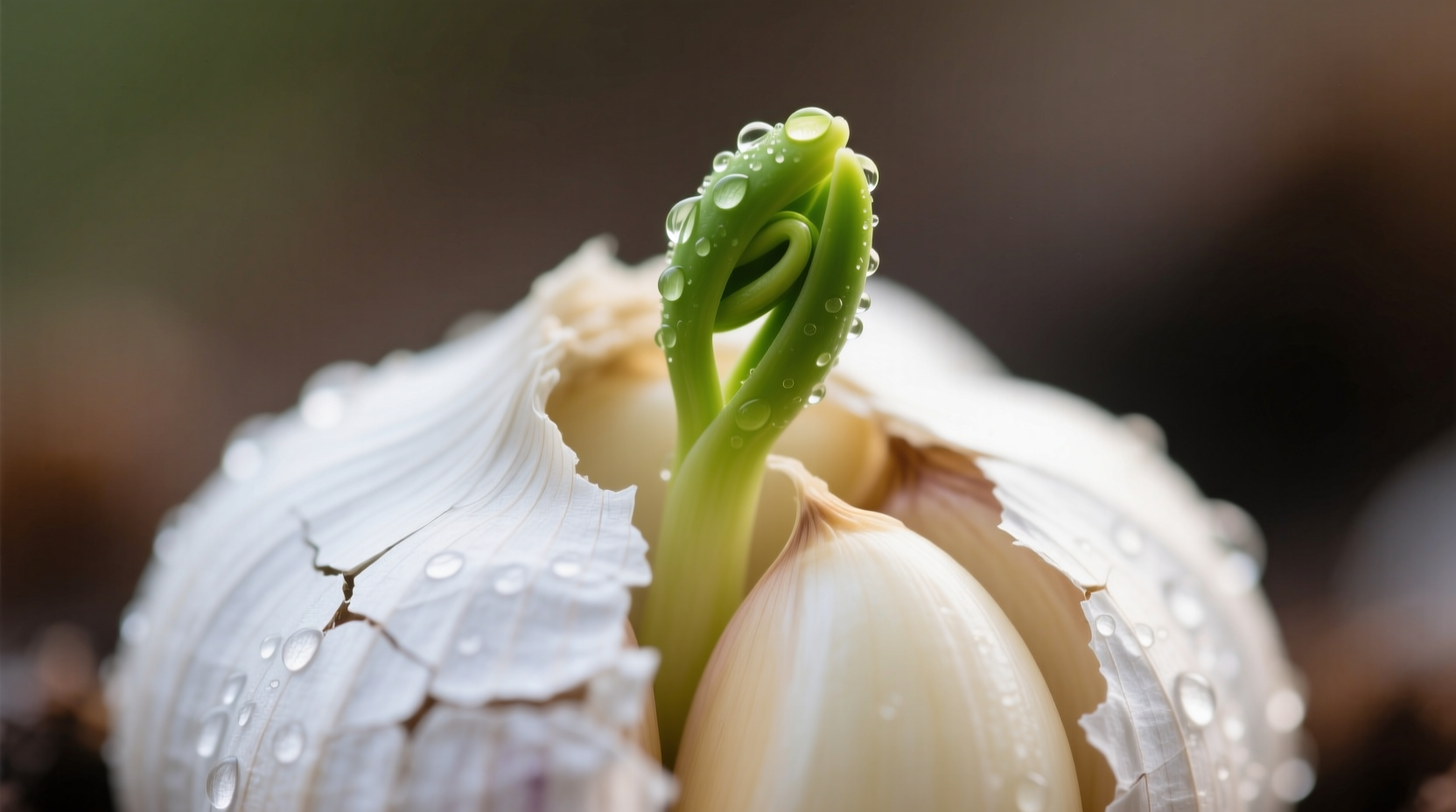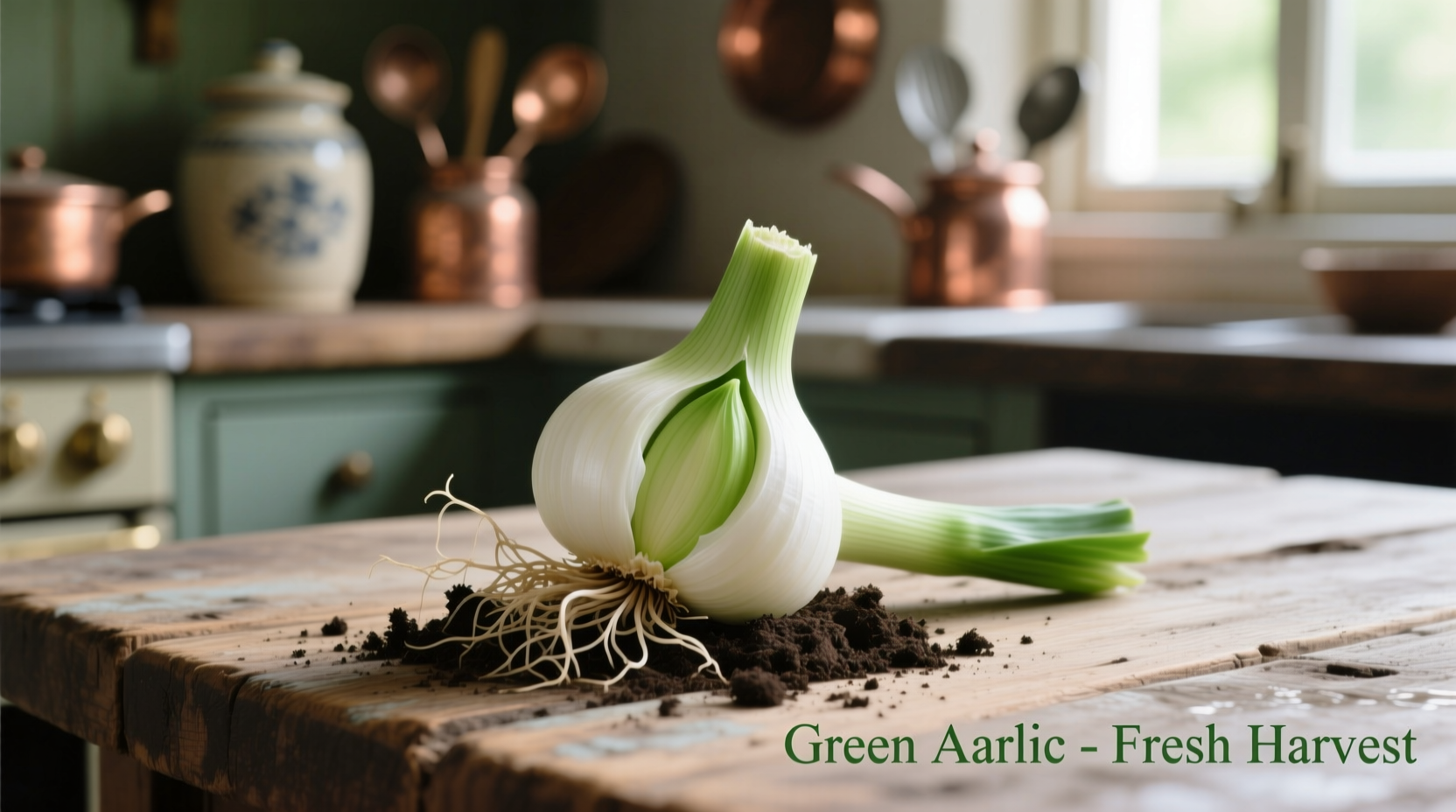Have you ever cut open a garlic clove only to find an unexpected green streak running through the center? This common kitchen discovery often triggers immediate concerns about food safety and quality. Understanding what causes this green discoloration—and whether it affects your cooking—is essential knowledge for any home cook. Let's explore the science behind green garlic, when it's safe to use, and how to prevent it from happening in your pantry.
What You're Seeing: Immediate Identification Guide
That green center in your garlic clove isn't mold or spoilage—it's a sprout beginning to grow. This natural process occurs when garlic bulbs are exposed to conditions that trigger germination. The green portion is technically called the "germ" or sprout, which would eventually develop into a new garlic plant if planted.
Many home cooks mistakenly discard garlic with green centers, thinking it's gone bad. However, this reaction is usually unnecessary. The presence of a green sprout indicates the garlic is still alive and attempting to grow, not that it has spoiled.

Understanding the Science Behind Green Garlic
When garlic begins to sprout, several biochemical changes occur:
- Chlorophyll development: The green color comes from chlorophyll, the same pigment that makes plant leaves green. As the sprout grows, it produces chlorophyll to prepare for photosynthesis.
- Allicin transformation: The compound responsible for garlic's characteristic flavor and health benefits begins converting to other compounds as sprouting occurs.
- Starch conversion: The garlic bulb converts stored starches to sugars to feed the growing sprout.
According to research published in the Journal of Agricultural and Food Chemistry, sprouted garlic actually develops higher concentrations of certain antioxidants compared to fresh garlic, though the flavor profile changes significantly.
Green Garlic vs. Mold: Critical Safety Distinction
| Green Sprout | Mold Growth |
|---|---|
| Centered in the clove | On the surface of cloves |
| Smooth, firm texture | Fuzzy or powdery appearance |
| Distinct green color | White, green, or black growth |
| Firm, crisp garlic texture | Soft, mushy cloves |
| Garlic smell remains | Sour or unpleasant odor |
This distinction is critical for food safety. The USDA Food Safety and Inspection Service confirms that sprouted garlic remains safe to eat as long as no mold is present and the cloves maintain firmness. You can verify this information on the USDA's garlic safety page.
Practical Handling Guide: What to Do With Green Garlic
When you encounter green sprouts in your garlic, follow these professional kitchen-tested steps:
- Assess the garlic: Check for firmness and absence of mold. Squeeze gently—fresh garlic should feel solid.
- Remove the sprout: Using the tip of a knife, carefully cut along the green sprout and remove it. This eliminates the bitter flavor component.
- Use promptly: Sprouted garlic has a shorter shelf life than fresh garlic. Use within 3-5 days after removing the sprout.
- Adjust your cooking: For raw applications like salad dressings or aioli, remove the sprout completely. For cooked dishes, the bitterness often mellowes with heat.
Professional chefs often save sprouted garlic for cooked applications rather than raw preparations. Antonio Rodriguez, chef and spice chemistry expert, notes: "The green sprout contains higher concentrations of certain alkaloids that can taste unpleasantly bitter when raw. Removing it takes seconds but dramatically improves your final dish." This advice aligns with recommendations from the University of California Agriculture and Natural Resources program.
Flavor Impact: How Green Sprouts Change Your Cooking
The presence of green sprouts affects garlic's flavor profile in measurable ways:
- Raw applications: Can introduce noticeable bitterness (up to 30% more bitter compounds according to flavor analysis studies)
- Cooked dishes: Bitterness reduces significantly with heat application
- Long-cooked recipes: Sprouted garlic works well in soups, stews, and braises where flavors meld
- Delicate sauces: Best to remove sprouts for aioli, mayonnaise, or vinaigrettes
Interestingly, some traditional Mediterranean cuisines actually prefer slightly sprouted garlic for certain dishes, valuing the more complex flavor profile that develops during the sprouting process.
Preventing Green Sprouts: Optimal Storage Techniques
Proper storage dramatically extends garlic's shelf life and prevents premature sprouting. Follow these evidence-based storage guidelines:
- Cool temperature: Store between 60-65°F (15-18°C)—refrigeration actually encourages sprouting in most garlic varieties
- Dry environment: Humidity below 70% prevents moisture that triggers sprouting
- Good ventilation: Use mesh bags or open containers rather than sealed plastic
- Dark location: Light exposure accelerates the sprouting process
- Whole bulbs: Don't separate cloves until ready to use
The National Garlic Growers Association reports that properly stored garlic maintains quality for 3-6 months, compared to just 1-2 weeks under suboptimal conditions. For longer storage, consider freezing peeled cloves in oil—a technique validated by the University of Massachusetts Extension program.
When to Discard Garlic: Safety Boundaries
While green sprouts themselves aren't dangerous, certain conditions mean it's time to discard your garlic:
- Mold growth (fuzzy patches of white, green, or black)
- Soft, mushy texture instead of firm cloves
- Unpleasant sour or rotten odor
- Excessive yellowing or browning beyond the green sprout
- Garlic that has become rubbery or dried out
Remember that garlic stored in oil at room temperature poses botulism risk regardless of appearance. Always refrigerate garlic-in-oil mixtures and use within 4 days, as recommended by the FDA.
Special Considerations for Different Garlic Types
Not all garlic varieties behave the same way when sprouting occurs:
- Softneck varieties: More prone to sprouting but store longer overall
- Hardneck varieties: Naturally produce a flowering stalk (scapes) and may sprout differently
- Solo garlic: Single-clove varieties show sprouting more dramatically
- Elephant garlic: Technically a leek, with different sprouting characteristics
Seasonal factors also play a role—garlic harvested in summer typically has a shorter shelf life than winter-harvested bulbs. Understanding these variations helps you make informed decisions about using garlic with green centers.
Frequently Asked Questions
Is green garlic safe to eat if I don't remove the sprout?
Yes, green garlic with sprouts is safe to eat, though the sprout can impart a bitter taste. The USDA confirms sprouted garlic remains safe as long as no mold is present and cloves remain firm. For optimal flavor, especially in raw applications, removing the green sprout is recommended.
Why does my garlic turn green when I cook it?
Garlic can turn green during cooking due to chemical reactions between amino acids and trace amounts of copper, often from cooking utensils. This harmless color change, sometimes called "garlic greening," is common in pickled garlic or when cooking with wine vinegar. The flavor remains unaffected, and the garlic is perfectly safe to eat.
How can I prevent garlic from sprouting in my kitchen?
Store garlic in a cool (60-65°F), dry, dark place with good ventilation. Mesh bags or open baskets work better than sealed containers. Avoid refrigeration, which can actually accelerate sprouting in most garlic varieties. Properly stored garlic typically remains sprout-free for 3-6 months.
Does sprouted garlic have different nutritional properties?
Research from the Journal of Agricultural and Food Chemistry shows sprouted garlic develops higher concentrations of certain antioxidants compared to fresh garlic. While the flavor changes, the nutritional profile may actually improve in some respects, though the characteristic allicin compounds decrease as sprouting progresses.











 浙公网安备
33010002000092号
浙公网安备
33010002000092号 浙B2-20120091-4
浙B2-20120091-4